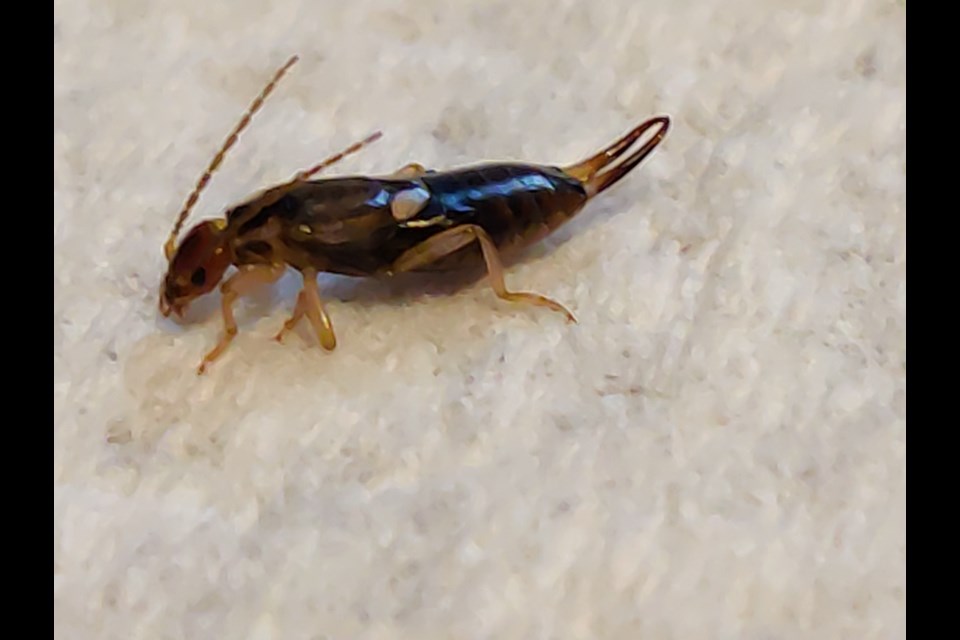The first time I saw an earwig, it was a bit intimidating because of the pincers on the back end.
I knew almost nothing about them, so I decided to check them out and share because they are quite common around Longmont.
The name is derived from an urban myth about earwigs crawling into some hapless person’s ear canal and eating its way into the brain. Of course, this is only a myth so you don’t need to suddenly start wearing earplugs to bed at night to keep them out.
The name comes from the English word “earwicga,” which means “ear wiggler.” The European earwig is native to Europe, northern Africa, and western Asia and was accidentally introduced to the United States. The European earwig is the most common introduced earwig in the United States, but there are also native species here. First appearing in Seattle, Washington, the earwig most likely was brought over in a shipment of flowers, fruits or vegetables, according to Penn State New Kensington. It isn’t known how the earwig arrived and given its amazing survival abilities, it could have hitched a ride on a shipment of almost anything.
Since arriving in the United States, the earwig has managed to expand to every state. European earwigs arrived in Colorado during the 1950s and are the only earwigs here except for one other species in extreme southern Colorado.
The United States has 22 species of earwig, 12 of which were introduced and the remaining 10 are native. Four of these are classified as being pests or potential pests. Despite this, earwigs are beneficial insects, playing an important part in the ecosystem. They shred material and make it into small particles, which helps the soil decomposer community. Earwigs also act as predators for a number of other insect pests such as aphids, caterpillars, midges and beetles,an especially important role in organic farming.
Earwigs are approximately a half-inch long with females being larger than males. Their bodies are dark, reddish-brown, their heads are reddish and their legs are yellowish. Earwigs have two long antennae and very visible pincers (called cerci) at the end of their abdomens. Although they have two flight wings, earwigs seldom use them.
According to the University of Florida entomology department, you can distinguish between male and female earwigs by the shape of their pincers;males have curved pincers and females have straight pincers. The pincers are used to grab and hold prey and during male mating competitions.
Because earwigs are solitary, they have not developed any social or communication systems. Mating occurs once a year in autumn, during which time males find females by a scent (pheromone) excreted in the feces. Obviously, more than one male will be attracted by this and they compete with each other to mate with the female. Successful males tend to have larger body and pincer sizes.
After mating, females will dig out a nest and lay 30 to 50 eggs. The nest also is used by both the male and the female to hibernate. The female will variously stack the eggs to keep them safe from predators and fungus. Eggs hatch in the spring and the nymphs (first instar stage) are cared for in the nest by the female.. For approximately the first month of life, the female will feed the nymphs with regurgitated plant materials. This level of care is unusual in insects.
It takes two to three weeks for the nymphs to end the second instar stage. Then the nest is opened and the nymphs begin going out at night to hunt, returning to the nest during the day.
In the third instar stage, nymphs find their own shelter and are hunting on their own. By late summer to early fall, the nymphs mature into adults and begin mating. Sometimes, adult females lay a second clutch of eggs that hatches and goes through all the stages much more rapidly, with the nymphs from the second clutch maturing at the same time as the nymphs that were in the nest during the winter.
Earwigs are nocturnal insects, spending the day in dark, moist places such as under rocks or flower pots. They are omnivorous insects and will eat both live and decaying plant material, aphids, spiders, insects and insect eggs. Although they might eat flower plants, fruits and vegetables, they typically only do so when there isn’t enough other prey available.
Earwigs are notorious for being able to work their way into small spaces and may be found inside houses, where they eat stored food products. They also secrete a smelly substance that can foul clothes and books.
Unless handled, earwigs are not likely to bite or use their pincers. If handled, the pincers can produce mild pain.
Earwigs are eaten by birds, such as chickadees and nuthatches, as well as by amphibians, particularly toads. There is a fly that parasitizes them, and earwigs are susceptible to bacterial and fungal infections.
In Colorado, most problems with earwigs will occur from mid-July to mid-September. If you prefer not to share your living space with earwigs, it is suggested you try to remove their habitat. This would include getting rid of places they might hide during the day, such as rocks, flower pots, logs or leaf litter. However, because they are so adept at finding even the smallest of places to hide, this doesn’t seem likely to be wholly successful.
A better bet might be trying to eliminate moist spots along the foundation of the house. Direct rain gutters and spouts away from the foundation and caulk or use weather stripping around windows, doors and pipes. The Colorado State University Extension website has more non-chemical control ideas.
Overall, earwigs are beneficial insects and should be left alone.



